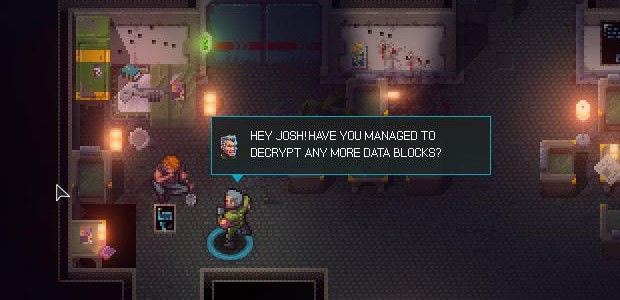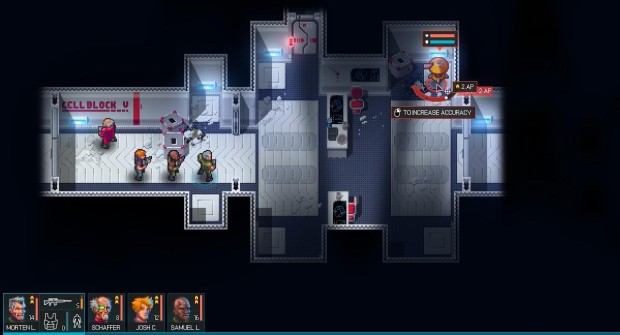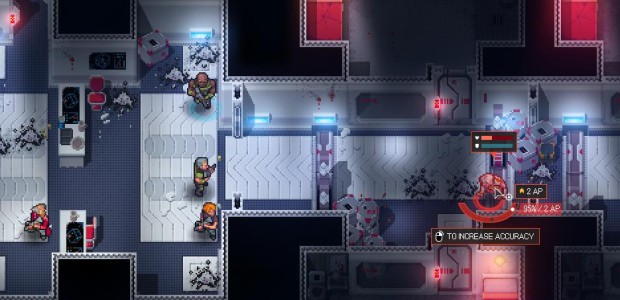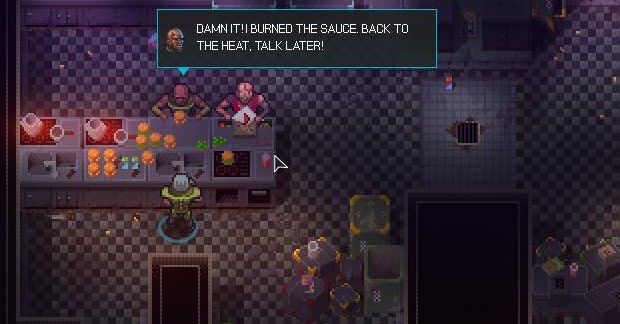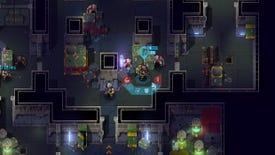Wot I Think: Halfway
Space Peril
Halfway is almost there, but not quite. It’s also a turn-based tactics game in the vein of XCOM, but with a fixed cast of characters rather than permadying squaddies and none of that base-upgrading meta stuff. It’s set in space and often in between it; some mysterious calamity has sent the starship Goliath ricocheting in and out of hyperspace limbo, the “halfway” of the title. As the only surviving crew members, your ragtag group must reclaim the vessel from an unidentified invading force by shooting in their general direction over low walls and hissing with exasperation at the inventory system.
Though much hissing there has been, there has also been cooing. Cooing at the lovely, moody pixelart graphics, which obliquely project the desolate quarters of the Goliath into a neat grid, and at the soundtrack of eerie celestial synths. I like, too, the pace of its action, the methodical positioning of units to maximise crossfire, synchronising the timing of cooldowns to skewer a particular enemy with a trio of special skills. And then - hiss - my plans are scuppered by wierdo to-hit percentages, or enemies that I’m certain I should be able to see, but can’t. Coo, hiss, coo, hiss. My playthrough has sounded like a pigeon trying to fuck a snake.
Let us for the moment concern ourselves with those things which have kept the pigeon’s feathers plumped: the spaceship Goliath itself, with its lonely corridors and flickering lights is no novel setting, but it is an attentively detailed one. Although its halls, now emptied of people, are cluttered with makeshift blockades and scorched with the marks of battle, it feels like a once-living vessel - not the impossibly grim gunmental-and-girders space-squat of so many survival horror games, but a place which once served a colony of people’s needs in relative comfort. I enjoyed the little flourishes of detail: the stockpile of coffee mugs in one bedroom, the arrangement of pot plants in another, or, more grimly, the piles of shells trailing back from a broken barricade to an inevitable gory stain. Between each mission you return to the canteen you’ve converted into a base of operations, and witness how it has been colonised by new teammates: veteran jarhead Samuel directs a rescued cyborg to cut vegetables in the kitchen, while brooding gun-for-hire Jenna polishes her heirloom hunting rifle. In another corner, the group’s only class A citizen, a prissy professor named Shaffer, spats with a delinquent techie amid a nest of snaking cables.
During these time-outs from battle, you take control of just one character - grizzled crew-cut soldier, Morten - and can have brief conversations with each of your crew. These exchanges mostly keep to brass tacks, and the writing is rarely so flavourful or plentiful to allow much backstory to escape, but eventually intriguing motes of plot do waft out of these interactions. There’s no branching dialogue trees to allow you to really explore these people, and there are no mechanics by which to curry favour or cultivate relationships. No Fire Emblem, this; it’s clear the game’s budget has kept its narrative ambitions in check. What you get instead is a serviceable yarn of space peril, told in the most economical fashion - and though it struggles to draw you in, it provides a pleasant tonal and textural respite from the game’s combat encounters.
There’s a lot I like about the combat, but the majority of that is also, simply, what I like about turnbased tactics games in general. I like their method and I like their rhythm. Halfway has no stellar additions to this formula, but it is enough of an adequate imitator to scratch that certain itch. Units have two action points to spend on moving, shooting, lobbing grenades, activating special skills, reloading, healing and switching inventory. If you choose to shoot, and you want to hit anything, you should also bother to aim - at the cost of an extra point. You can also set your units to retaliate, which is like XCOM’s overwatch, only crap. Instead of being a shoot-on-sight command, it’s a shoot-if-you’ve-personally-been-shot command, which makes precious little tactical sense, and is kind of useless anyway, given that the retaliatory volley doesn’t benefit from that extra aiming action point. Your team-mates can be gunned down all around, but ol’ dead-eye Dick will just stand there peering down his iron-sights, waiting to be hit by a bullet. Hiss.
Each of your team has a unique skill, and working out the ways in which particular unit configurations can be synchronised to lethal effect is a joy. It doesn’t go far enough, perhaps - having units that could buff one another would make experimental combinations more exciting - but there’s still a significant pleasure in orchestrating a successful takedown by getting Josh to overload an enemy’s shield before Morten fires his guaranteed-to-hit Steady Shot, or using Shaffer’s scanning ability to reveal a cluster of hidden opponents before dashing a berserk Jenna into their midst.
Another neat, but not unique system, is the game’s use of recharging shields to block a certain amount of damage. There is an armor value too, although its role in the maths of damage mitigation is not entirely clear. In fact, that’s the game’s lingering problem for me: its numbers don’t add up in a way I seem to be able to intuit. To-hit percentages are consistently surprising, and it undermines the tactical effort of positioning your troops. If your plan hinges on you dashing out of cover and nailing the dude two squares away from you, standing in the open, it’s with some dismay that you discover you only have a 12% chance of hitting him at all. But the guy 15 squares away, across a chasm, standing behind a wall and two rows of low cover? That’s 30%. Hiss, and also hwuh?
Such a situation can occur, I guess, because the three classes of weapons have severe range restrictions. A post-launch patch made this more visible by stating the maximum distance each weapon can shoot, but it’s still not clear if there’s some sort of sweet-spot in the middle or how your chance to hit tails off either side of this Goldilocks zone. Other things puzzle me too: a sniper rifle is described as highly accurate in its flavour text, yet it has an accuracy rating of four, lower than a crummy shotgun that never lands a shot more than two squares away. What does that number mean? How does it interact with the range restrictions of the weapon? How does it interact with the accuracy stat of the person firing it? None of these things are clear, and - when combined with the fact that potential sightlines are so hard to read - your tactical decisions often feel too much like roulette.
A more clearly-writ trade-off is that the more powerful weapons come with a meagre clip-size. Not only is there a disincentive to spend lots of action points reloading, but the game quite cannily balances its weapon classes via its universal ammo economy and the fact that every clip takes up a precious inventory slot. Having a sniper rifle that can only fire three shots before devouring another clip is a big sap on the limited resources your team can heft about. Only one character in the game has more than eight inventory slots, and after you’ve accounted for medkits, shield cells (which you can use mid-battle rather than wait for your shield to recharge) and a grenade or two, snipers risk only having a handful of shots to spend across an entire battle.
It’s a tense but fair compromise, and the inventory system has the one usability perk of letting you swap items between units regardless of where they’re standing - so ammo-rich characters can resupply others in battle, albeit at the cost of an action point. The inventory system otherwise manages to be a colossal ball-ache, alas, with a fussy menu system that only permits you to dig into one character’s pockets at a time. It has mad little quirks: because you can never leave a character without a gun it’s impossible to get two of your units to swap weapons unless you have a spare weapon to trade in and out of their inventory slots. And because inventory space is always at a premium, picking anything up invariably involves a slightly tedious bout of pass-the-parcel.
If I seem overly preoccupied by snipers in this review, it’s because they are really the only viable build until the midpoint of the game. The opening missions see you quickly acquire three characters - none of whose stats obviously bias them to one role or another, and none of whom can withstand more than a few shots. There’s no obvious tank here, and the enemy AI, particularly at the start of the game, is predisposed to swarm your weakest units. Since there’s no way to draw aggro, you might as well focus on thinning out the numbers at range. Eventually, your missions have you rescue a full complement of squadmates: eight in total, and one of them with a large enough health pool to suck up the pain and powerful melee attacks to boot. He can also teleport to any location visible to him, allowing you to dollop him right on top of the enemy. And yet, even he struggles to stay standing under the combined fire of the weakest enemies - you’ll need a huge supply chain of medkits to fuel this strategy, and it never seems altogether economic.
Nonetheless, the game’s systems slot more easily into place at this point. Levels start to deny you long range sightlines, forcing you to re-specialise some characters with close range weaponry. A steady supply of stat-boosting stimpaks lets you even out some of the annoying unit imbalances presented by the early game, and your team, now touting high-level armour suits with an array of buffs, becomes vastly more capable and versatile. Suddenly, a smattering of side-missions open up, giving your campaign strategy a cursory sense of freedom, excavating little moments of plot and relationships between characters. It’s ironically apt given the title, but the game comes into its own halfway through. It feels like it was balanced for the resources, manpower and capabilities that you find at your disposal only then - and haphazardly hacked back for the opening hours in order to generate a sense of progression.
But even as it threatens to take off, Halfway stumbles, repeatedly bushwhacking you with post-cutscene enemy spawns, who sometimes get to attack you first in open ground you would not have chosen to stand in. I’ve had one squadmate of a two-man squad downed outright before I even touched the keyboard. Never do this, games. Never do this. Least of all in a game - in a genre - whose joys are principled upon planning. And that’s Halfway’s fatal flaw: undermining its own potential for tactical reasoning, whether that’s via abrupt enemy spawns, unknowable hit-percentages or those frequent instances when the cursor tool-tip stubbornly claims an enemy is out of sight in defiance of what appears to be the case on screen.
Given the recent patch, it may be that the devs will continue to make the game’s calculations more transparent. I hope they do, and drag-’n’-drop some love to the inventory system while they’re at it. But even with all its flaws, Halfway has some considerable charm. I so love its mood and its detail. The heft of a critical sniper shot that smears an enemy into dust. The way shell casings clatter to the floor about a character’s feet. The pigeon may be dead, but the snake is pregnant.
Halfway is out now and costs $13 direct from the developers or on Steam.


